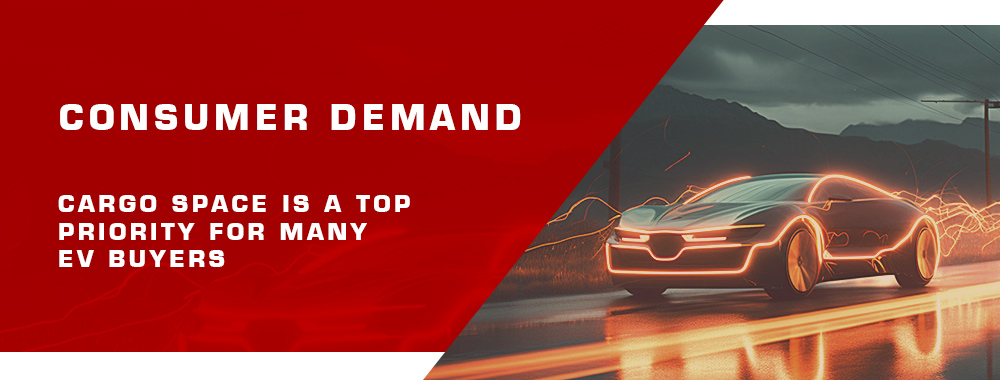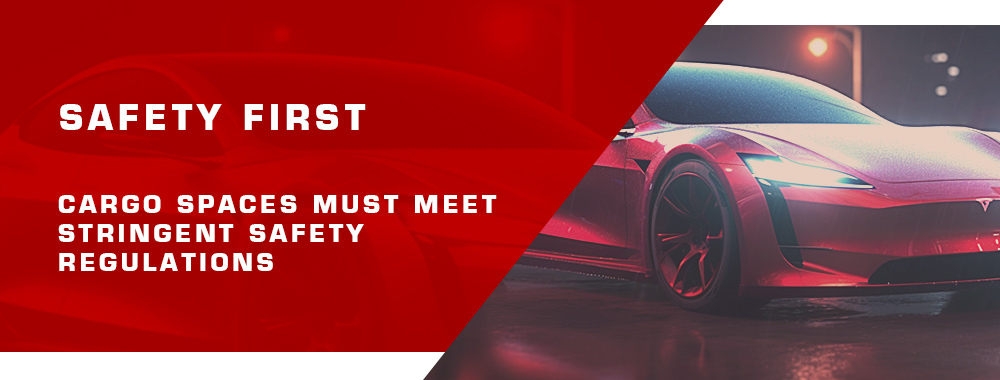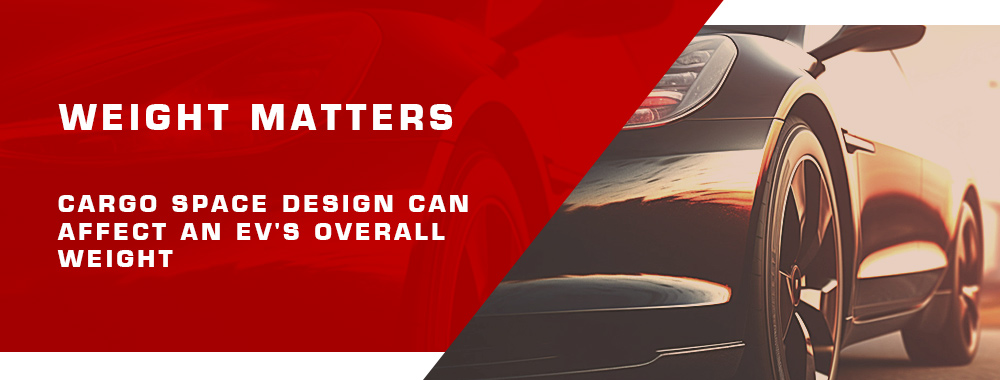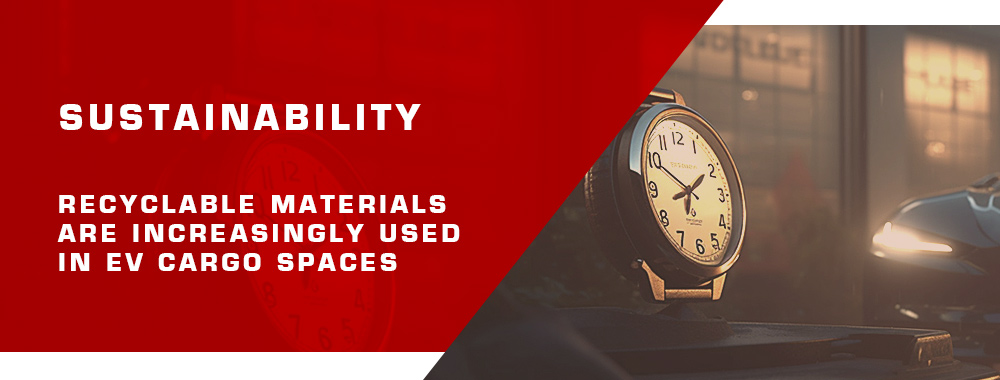Why Geometry Matters: The Art of Maximizing EV Cargo Space
When it comes to electric vehicles, every inch counts. The geometry of the cargo space is not just a matter of aesthetics; it’s a complex puzzle that engineers and designers must solve to achieve the perfect balance between functionality and style. Recent studies have shown that optimizing the geometry of the cargo area can significantly increase storage capacity without compromising the vehicle’s performance.
Did You Know?
According to Forbes, the geometry of a vehicle can even influence its self-driving capabilities. Now, that’s what we call multi-tasking design!
Material Matters: Crafting Lightweight Yet Spacious EV Cargo Areas
Choosing the right materials for the cargo space is like picking the right ingredients for a gourmet meal. The wrong choice can spoil the whole experience. Lightweight materials such as carbon fiber and aluminum alloys are increasingly being used to maximize cargo space while reducing the overall weight of the vehicle. This not only enhances fuel efficiency but also allows for more creative design possibilities.
Spotlight on Innovation
Did you know that some companies are experimenting with recyclable materials for cargo spaces? This not only makes your vehicle eco-friendly but also opens up new avenues for sustainable design.
Breaking the Mold: Modular Design in EV Cargo Spaces
Modular design is the future of electric vehicle cargo spaces. Imagine being able to customize your cargo area for different needs—be it a weekend getaway or a business trip. Modular design allows for such flexibility, offering removable and adjustable components that can be rearranged to suit specific requirements.

Zeroing In
- Flexibility: Modular design offers unparalleled flexibility, allowing you to adapt the cargo space as per your needs.
- Efficiency: With modular components, you can optimize the use of space, ensuring that no inch goes to waste.
- Innovation: The modular approach paves the way for incorporating advanced features like smart storage solutions and automated loading systems.
Elevate Your Knowledge
If you’re as fascinated by the intricacies of EV cargo space design as we are, stay tuned for our upcoming sections on technological innovations, user experience, and market trends. Trust us, you won’t want to miss it!
Revolutionizing Storage: Technological Innovations in EV Cargo Space
Smart Cargo Management Systems: The Brain Behind the Space
Imagine a cargo space that thinks for itself, optimizing storage in real-time based on the items you’re carrying. Welcome to the world of Smart Cargo Management Systems in electric vehicles. These systems use sensors and machine learning algorithms to categorize, arrange, and even suggest the best way to utilize the cargo space. Automotive World reports that this technology is not just a concept but is already in the development phase.
Elevate Your Understanding
Smart Cargo Management Systems can also integrate with your smartphone, allowing you to plan your cargo layout even before you start packing. Now, that’s what we call smart planning!
Automated Loading and Unloading: The Future is Hands-Free
Why lift a finger when your EV can do the heavy lifting for you? Automated loading and unloading solutions are making this a reality. Using a combination of robotics and advanced sensors, these systems can safely and efficiently load or unload your cargo. The benefits are twofold: it saves time and reduces the risk of injury.
The Sky’s the Limit
Automated systems are not just for cargo; they’re paving the way for fully automated electric vehicles. Imagine a future where your EV not only drives itself but also takes care of all your storage needs.
Augmented Reality: The Final Frontier in EV Cargo Management
Augmented Reality (AR) is set to redefine how we interact with EV cargo spaces. With the help of AR glasses or even through your smartphone, you can visualize how to arrange your cargo in the most efficient way. This technology can also guide you through the loading process, ensuring that you make the most out of every square inch.

Roll the Dice on Innovation
- Interactivity: AR adds an interactive layer to cargo management, making it more engaging and efficient.
- Customization: With AR, you can customize your cargo layout based on specific needs, whether it’s for a camping trip or transporting goods.
- Future-Proof: As AR technology evolves, we can expect even more advanced features that will make cargo management a breeze.
Ignite Your Curiosity
If you’re intrigued by the technological leaps in EV cargo space, you won’t want to miss our upcoming deep dives into user experience and sustainability. The future of EV cargo space is not just about space; it’s about how technology can make that space smarter, more efficient, and more adaptable to our needs.
Driving Satisfaction: User Experience in EV Cargo Space
Consumer Preferences: The Heartbeat of EV Cargo Space
What do consumers really want when it comes to EV cargo space? The answer isn’t as straightforward as you might think. While some prioritize maximum storage capacity, others are looking for smart organization features. A J.D. Power study reveals that consumer preferences are shifting towards a blend of both, making it crucial for designers to strike the right balance.

Lucky You!
Some electric vehicles now offer “Cargo Mode,” a feature that automatically reconfigures the interior to maximize cargo space. It’s like having a magic button that instantly transforms your vehicle!
Accessibility and Usability: The Yin and Yang of EV Cargo Design
Ever struggled with loading groceries or sports equipment into your car? Accessibility and usability in EV cargo design aim to eliminate such hassles. From low loading heights to hands-free tailgate systems, the focus is on making the cargo space as user-friendly as possible.
The More You Know
Accessibility isn’t just about ease of use; it’s also about inclusivity. Some electric vehicles are incorporating features like adjustable cargo floors to make them more accessible for people with disabilities.
Real-world Scenarios: Where the Rubber Meets the Road
It’s one thing to design an impressive cargo space, but how does it hold up in real-world scenarios? Whether it’s a family road trip or a run to the hardware store, the true test of any EV cargo space is its performance under diverse conditions. This is where features like durable materials and adaptive storage solutions come into play.
Behind the Curtain
- Adaptability: Some EVs offer “scenario-based” cargo settings, allowing you to pre-set configurations for specific activities like camping or moving.
- Resilience: Real-world testing often involves extreme conditions to ensure the cargo space can withstand the rigors of daily use.
- Practicality: It’s not just about how much you can fit, but also how easily you can access and secure your belongings.
Unveil the Mysteries
If you’re captivated by the nuances of user experience in EV cargo space, you’ll be thrilled by our forthcoming sections on regulatory compliance and sustainability. The journey through the world of EV cargo space is far from over, and the road ahead promises to be both enlightening and exhilarating.
Safety Standards: The Bedrock of EV Cargo Space
When it comes to electric vehicles, safety is not just a feature—it’s a mandate. From fire-resistant materials to secure cargo anchoring systems, safety standards for EV cargo space are stringent and continually evolving. The National Highway Traffic Safety Administration (NHTSA) sets the bar high, ensuring that your belongings—and more importantly, you—are safe.

Safety Lockbox
Some electric vehicles are now incorporating “smart” safety features in the cargo area, such as sensors that detect hazardous materials and alert the driver. Safety has gone high-tech!
Environmental Regulations: The Green Side of the Coin
As electric vehicles aim to reduce the carbon footprint, the materials used in their cargo spaces are also under scrutiny. Environmental regulations are pushing manufacturers to adopt sustainable, recyclable, and non-toxic materials. The Environmental Protection Agency (EPA) plays a pivotal role in setting these standards.
Eco-Friendly Footnote
Did you know that some EVs use recycled ocean plastics in their cargo spaces? It’s a win-win for both consumers and Mother Earth!
Global Variations: A Regulatory Patchwork
Regulatory compliance isn’t a one-size-fits-all scenario. Different countries have their own sets of rules and standards for EV cargo space. For instance, European regulations may focus more on sustainability, while American standards might emphasize safety features. This creates a complex landscape that manufacturers must navigate.
Around the World in 80 Rules
- Adaptability: Manufacturers often have to modify their designs to meet regional regulations.
- Harmonization: Efforts are underway to harmonize regulations globally, making it easier for manufacturers to comply.
- Localization: Some countries require the use of local materials in EV cargo spaces, adding another layer of complexity.
Unwrap the Complexity
If you’re intrigued by the labyrinth of regulations shaping the future of EV cargo space, you’ll be spellbound by our upcoming sections on market trends and sustainability. The regulatory landscape is as dynamic as it is intricate, and understanding it can give you a unique perspective on the world of electric vehicles.
Marketplace Dynamics: Trends Shaping EV Cargo Space
Competitive Analysis: The Chessboard of EV Cargo Space Offerings
As electric vehicles surge in popularity, the competition is heating up, especially in the realm of cargo space. Brands are vying for consumer attention with innovative storage solutions, smart compartments, and even modular designs. A recent McKinsey report highlights how this competitive landscape is influencing design choices and driving technological advancements.
Bullseye Insights
Some automakers are taking the competition to the next level by offering “Cargo Space as a Service,” allowing users to customize and upgrade their storage features through software updates. Talk about staying ahead of the game!
Emerging Markets: The New Frontiers for Spacious EVs
While developed markets like the U.S. and Europe continue to dominate the EV landscape, emerging markets are showing a growing appetite for electric vehicles with ample cargo space. Countries like India and Brazil are becoming hotspots for spacious EVs, driven by consumer needs for versatile vehicles that can serve multiple purposes.

Seeds of Change
Emerging markets are not just consumers but also innovators. Local startups are developing unique cargo solutions tailored to regional needs, such as electric delivery vans with specialized storage compartments.
Consumer Behavior: The Pulse of EV Cargo Space
Consumer preferences are a moving target, and understanding them is crucial for any successful product. When it comes to EV cargo space, trends show a growing demand for multi-functional areas that can adapt to various lifestyles. Whether it’s the weekend adventurer or the urban commuter, the cargo space needs to be as versatile as the people using it.
Crystal Ball Gazing
- Flexibility: Consumers are increasingly looking for “transformable” cargo spaces that can easily switch between different functions.
- Connectivity: The integration of smart technologies into the cargo area is becoming a selling point, especially among tech-savvy buyers.
- Personalization: Customizable cargo features are on the rise, allowing users to adapt the space according to their specific needs.
Ride the Wave of Innovation
If you’re fascinated by the market trends shaping the future of EV cargo space, hold on tight! Our upcoming sections on sustainability and case studies promise to take you on a rollercoaster ride through the ever-evolving world of electric vehicles. Buckle up!
Green Horizons: Sustainability in EV Cargo Space
Recyclable Materials: The Circle of Life in EV Cargo Space
As the world grapples with environmental challenges, the automotive industry is not far behind in joining the green revolution. The use of recyclable materials in EV cargo spaces is more than a trend; it’s a necessity. From recycled plastics to bio-based fabrics, the materials are chosen not just for their durability but also for their end-of-life recyclability. A Green Car Reports article outlines how this shift is becoming mainstream.

Star of Sustainability
Some electric vehicles are taking sustainability to the next level by using materials that are not just recyclable but also sourced from ethical and sustainable supply chains. A holistic approach to green!
Energy-Efficient Design: The Low Carbon Footprint of EV Cargo
Energy efficiency isn’t just about the electric engine; it extends to the cargo space as well. Innovative designs aim to reduce drag and weight, thereby enhancing the vehicle’s overall energy efficiency. Lighter materials, aerodynamic shapes, and smart technology all contribute to a cargo space that’s as green as it is functional.
Power Saver Alert
Some EVs are incorporating solar panels into the cargo area, capable of powering internal lights or even contributing to the vehicle’s energy needs. Talk about harnessing the sun!
Sustainability Certifications: The Green Stamp of Approval
How do you know your EV’s cargo space is genuinely sustainable? Look for certifications! Various organizations offer sustainability certifications that assess the environmental impact of the materials and design features in EV cargo spaces. These certifications serve as a reliable indicator for consumers who prioritize eco-friendliness.
Global Green Goals
- Transparency: Certifications often require full disclosure of materials, making it easier for consumers to make informed choices.
- Accountability: Regular audits ensure that manufacturers adhere to sustainability standards.
- Innovation: The quest for certification often drives companies to innovate, leading to even greener solutions over time.
Planting Seeds for the Future
If you’re as passionate about sustainability as we are, you’ll be thrilled by our upcoming sections on case studies and design fundamentals. The green revolution in EV cargo space is just getting started, and there’s so much more to explore and discover. Stay tuned!
From Theory to Practice: Case Studies in EV Cargo Space
Success Stories: The Pioneers of Innovative EV Cargo Space Designs
When it comes to innovation, some electric vehicle manufacturers have truly broken the mold. Companies like Tesla and Rivian have redefined what we can expect from an EV cargo space. Tesla’s ‘frunk’ (front trunk) and Rivian’s gear tunnel are examples of how thinking outside the box can revolutionize storage solutions. A Car and Driver feature delves into the history and impact of these innovations.
Eureka Moments
Did you know that Rivian’s gear tunnel comes with a built-in air compressor? This allows for inflating tires or even air mattresses right from your cargo space. Convenience meets innovation!
Lessons Learned: The Roadblocks in EV Cargo Space
Not all attempts to innovate in EV cargo space have been successful. Some designs have faced challenges such as poor weight distribution, leading to handling issues. Others have struggled with material choices that compromised either durability or sustainability. These lessons serve as valuable insights for future designs.

Cautionary Tales
One manufacturer’s attempt to integrate a cooler into the cargo space backfired when it affected the vehicle’s overall thermal management. Sometimes, less is more!
Case Study: The Role of EV Cargo Space in Commercial Fleets
Commercial fleets are increasingly turning to electric vehicles, and the cargo space plays a significant role in this transition. Companies need versatile and efficient storage solutions to meet the demands of their operations. From delivery vans with modular shelving to utility vehicles with specialized compartments, the commercial sector is a testing ground for innovative cargo space designs.
By the Numbers
- Efficiency: Commercial fleets report up to a 20% increase in operational efficiency with well-designed EV cargo spaces.
- Cost Savings: Reduced maintenance and fuel costs make EVs with optimized cargo spaces a financially sound choice for businesses.
- Customization: The ability to tailor the cargo space to specific business needs is a major selling point for commercial buyers.
The Final Word: A Comprehensive Analysis of EV Cargo Space
Drawing from our experience, we have found that the realm of EV cargo space is both multifaceted and ever-changing. Innovative designs aimed at maximizing utility coexist with rigorous regulations that focus on safety and sustainability. Our research indicates that consumer preferences and market trends add additional layers of complexity to this already intricate field. As the adoption of electric vehicles accelerates, we can conclude that cargo space will be a decisive factor in their market success or failure. Whether it’s for individual consumers who value versatility or commercial fleets aiming for operational efficiency, the significance of well-engineered, sustainable, and efficient cargo spaces is undeniable.
Contents
- 1 Why Geometry Matters: The Art of Maximizing EV Cargo Space
- 2 Material Matters: Crafting Lightweight Yet Spacious EV Cargo Areas
- 3 Breaking the Mold: Modular Design in EV Cargo Spaces
- 4 Elevate Your Knowledge
- 5 Revolutionizing Storage: Technological Innovations in EV Cargo Space
- 6 Ignite Your Curiosity
- 7 Driving Satisfaction: User Experience in EV Cargo Space
- 8 Unveil the Mysteries
- 9 Navigating the Maze: Regulatory Compliance in EV Cargo Space
- 10 Unwrap the Complexity
- 11 Marketplace Dynamics: Trends Shaping EV Cargo Space
- 12 Ride the Wave of Innovation
- 13 Green Horizons: Sustainability in EV Cargo Space
- 14 Planting Seeds for the Future
- 15 From Theory to Practice: Case Studies in EV Cargo Space
- 16 The Final Word: A Comprehensive Analysis of EV Cargo Space

I recently switched to a Rivian R1S and I’m blown away by the cargo space – 104.7 cubic feet with seats folded! It’s a game-changer for my camping trips. However, I’ve noticed some wear on the cargo mat. Anyone else experiencing this? Does it impact durability in the long term?
I’ve had my Rivian for 6 months now. The cargo mat does show some wear, but it’s held up well overall. I think it’s more about the material they use – durable but not invincible. I wouldn’t worry too much about long-term durability.
I’m torn between the Tesla Model X and BMW iX for my next EV. I need something with a good balance of cargo space and passenger comfort. The Model X offers 92.3 cubic feet, which is great, but I’ve heard the iX has a better interior. Thoughts?
Replying to EVenturer: As a Model X owner, I can say the cargo space is fantastic. But if interior quality is a priority, you might lean towards the BMW iX. It’s a tough choice, but both are great in their own ways.
Just got the software update for “Cargo Space as a Service” in my EV. It’s amazing how software can now enhance physical space utilization. Has anyone else tried this? Does it really make a noticeable difference?
Is anyone else frustrated with the lack of cargo space in smaller EVs? I love the sustainability aspect, but as someone who frequently hauls gear, it’s a struggle. Are there any compact EVs with decent cargo space out there?
It’s a common issue with compact EVs. However, the Kia Niro EV has a decent amount for its size – around 54.5 cubic feet. Might be worth checking out.
Just read about the all-electric 2025 Cadillac Escalade IQ – 119 cu. ft. of cargo space! That’s massive for an EV. It’s exciting to see luxury SUVs stepping up their game in the EV market.
Heading on a road trip with my electric SUV, and I’m amazed at how much I can pack into the 60.2 cubic feet of space. It’s not just about the volume, but how smartly the space is designed. Anyone else notice this with their EVs?
I’ve noticed a trend in EVs where cargo space is prioritized, but it sometimes feels like passenger comfort is compromised. Anyone feel the same? Or is it just me being too picky?
I think it depends on the model. Some EVs do a great job balancing both. My Tesla Model Y feels spacious both for passengers and cargo. But I agree, some models do sacrifice comfort for cargo space.